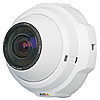Axis Communications 212 PTZ 212 PTZ/-V - User's Manual - Page 38
Maintenance, Support, Log Level for Log Files - axis factory reset
 |
View all Axis Communications 212 PTZ manuals
Add to My Manuals
Save this manual to your list of manuals |
Page 38 highlights
AXIS 212 PTZ/-V - System Options Maintenance • Restart - The camera is restarted without changing any of the settings. • Restore - The camera is restarted and most current settings are reset to factory default values. The settings that will not be reset are as follows: • the boot protocol (DHCP or static) • the static IP address • the default router • the subnet mask • Default - The default button should be used with caution. Pressing this will return all of the camera's settings to the factory default values (including the IP address) Upgrade Server - See Upgrading the Firmware, on page 42. Backup - To take a backup of all of the parameters, and any user-defined scripts, click this button. If necessary, it will then be possible to return to the previous settings, if settings are changed and there is unexpected behavior. Restore - Click the Browse button to locate the saved backup file (see above) and then click the Restore button. The settings will be restored to the previous configuration. Note: Backup and Restore can only be used on the same unit running the same firmware. This feature is not intended for the configuration of multiple units or for firmware upgrades. Support The Support overview page provides valuable information on troubleshooting and contact information. System Overview - Provides a quick look over the camera's status and settings. Information that can be found here includes the camera's Firmware version, IP address, Security, Event and Image settings and Recent log items. Many of the captions are also links to the proper Setup page to conveniently make adjustments in the cameras settings. Logs & Reports - When contacting Axis support, please be sure to provide a valid Server Report with your query. Information - the Server Report and Parameter List may prove useful when troubleshooting a problem or when contacting the Axis support web. System Log - Provides information about system events. Access Log - By default, the Access Log lists all failed attempts to access the camera but can be configured to list all connections to the camera, whether successful or not. The Access Log is useful for various purposes such as tracking all access to the camera, simple web attraction tracking, system analysis and troubleshooting. Server Report - Provides information about the server status and should always be included when requesting support. Parameter List - Shows the unit's parameters and their current settings. Connection List - Lists all clients that are currently accessing video. It is also used for system analysis and troubleshooting. Crash Report - Generates an archive with debug information for all running applications. This will typically take several minutes to generate. Technical support may ask for this information if you report a problem. Configuration Log Level for Log Files - From the drop-down list, select the level of information to be added to the Log file. Log Level for Email - From the drop-down list, select the level of information to send as email and enter the destination email address. 38















